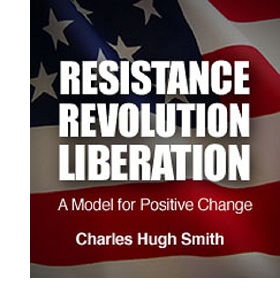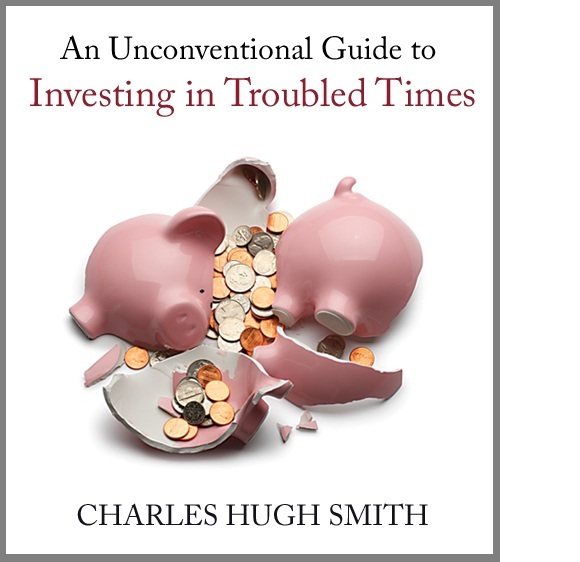

|

|
|||||||||||||
|
Why QE May Not Boost Stocks After All (September 26, 2012) What if the Fed throws a QE equity-ramp party and the fireworks fizzle? If there is one dominant consensus in the financial sphere, it is that the Federal Reserve's $85 billion/month bond-and-mortgage-buying "quantitative easing" will inevitably send stocks higher. The general idea is that the Fed buys the mortgage-backed securities (MBS) and Treasury bonds from the banks, which turn around and dump the cash into "risk on" assets like equities (stocks). This consensus can be summarized in the time-worn phrase, "Don't fight the Fed." This near-universal confidence in a QE-goosed stock market is reflected in the low level of volatility (the VIX) and other signs of complacency such as relatively few buyers of put options, which are viewed as "insurance" against a decline in stocks. The usual sentiment readings are bullish as well. But what if QE fails to send stocks higher? Is such a thing even possible? Yes, it does seem "impossible" in a market as rigged and centrally managed as this one, but there are a handful of reasons why QE might not unleash a flood of cash into "risk on" assets every month from now until Doomsday (i.e. December2015--the Mayans made one teeny addition error in Column 13). 1. Bullish sentiment. Though Mr. Market has been chained and whipped by central planning, he still harbors a mighty resistance to rewarding the majority in any trade, and with most traders firmly on the bullish side of the boat, Mr. Market might break free of the Fed's chains long enough to capsize the boat. As the saying goes, complacency leads to volatility, and stability leads to instability. Not all cycles can be voided by central planning, until Central Planners own 95% of every market (which seems to be the direction we're going here). 2. The technical case for QE yielding diminishing return. The Keystone Speculator (among several analysts pursuing the same line of inquiry) made a compelling case for a Fibonacci sequence playing out as each QE is launched:
Starting with the time, QE1 was a 13-month pump, so note the beauty in the Fibonacci sequence occurring; 13, 8, 5, 3. Thus, the current 3-month rally would already have achieved its target based on this metric. For the point moves and percentages, continuing along in the sequence would target about a 20% rally for the current QE3 pump, with about a 250-point move off the 1270-ish bottom which places price in the 1520's target area. "Don't fight the Fed" is the mantra, but the current rally appears far along already. In other words, the length and rise of each QE-goosed rally diminishes with each QE. If this pans out, the QE3 rally is within a few weeks of topping out and reversing. 3. The Fed has trained traders to front-run its decisions. The Fed has played a masterful PR game of describing its next round of intervention for months, keeping markets aloft in anticipation of the "free money" flood. In one of the unintended consequences that central planning excels in producing, the Fed has trained traders in Pavlovian fashion to front-run "risk on" assets, i.e. buy stocks before the Fed actually announces its latest market manipulation. As a result, stocks have already run up strongly so the "announcement" bounce is modest; everybody tempted to be bullish is already all-in, and disbelievers are wary of jumping in on the downside of "buy the rumor, sell the news." 4. The Fed has no surprises left. The market loves surprises, especially lavish gifts of free money from central banks, and now, 3.5 long years after the March 2009 lows in global equities, there are no more surprises left--unless the outright purchase of stocks by the Fed counts as a surprise. Interest rates are already near-zero, the Fed already owns a significant percentage of all long-term Treasury bonds (see The Fed Now Owns 27% Of All Duration, Rising At Over 10% Per Year, Zero Hedge), and it already bought $1.1 trillion in MBS and will keep buying more dodgy mortgages. So what's left to wrap up and deliver to a market addicted to free-money surprises every few months? Nothing. 5. Correspondent David P. explained the real mechanism at work in QE3--the enabling of fiscal "nearly free money" spending. The Fed creates money electronically and uses the cash to buy $45 billion of Treasuries every month. Since the Treasury now holds a preponderance of short-term bonds to keep interest rates down (as explained by Zero Hedge), it must issue an insane amount of bonds every month to roll over existing short-duration bonds and fund the Federal government's $1.2 trillion deficit. The only way the Treasury can get away with issuing trillions of dollars in bonds every year is if somebody buys and holds a big chunk of them, i.e the Fed. Here is David's explanation:
While Fed money printing doesn't make it to the marketplace, Federal government spending does, and Fed monetizing makes it so that Treasury borrowing doesn't negatively impact treasury markets and so Treasury rates don't increase. In other words, the pathway of the freshly printed money goes from the Fed to Treasuries and through deficit fiscal spending into the real economy. The amount of "new free money" flowing into equities may be a lot less than the consensus believes, as $500 billion of it has already been committed to enabling Federal deficit spending on a monumental and seemingly permanent level. New video program: The Federal Reserve: Flawed Premise, Mistaken Role:
 Resistance, Revolution, Liberation: A Model for Positive Change
(print $25)
Resistance, Revolution, Liberation: A Model for Positive Change
(print $25)
(Kindle eBook $9.95) Read the Introduction (2,600 words) and Chapter One (7,600 words) for free.
We are like passengers on the Titanic ten minutes after its fatal encounter with the iceberg: though our financial system seems unsinkable, its reliance on debt and financialization has already doomed it.

If this recession strikes you as different from previous downturns, you might
be interested in my book
An Unconventional Guide to Investing in Troubled Times (print edition)
or
Kindle ebook format. You can read the ebook on any
computer, smart phone, iPad, etc. Click here for links to Kindle apps and Chapter One.
The solution in one word: Localism.
Of Two Minds Kindle edition: Of Two Minds blog-Kindle

"This guy is THE leading visionary on reality.
He routinely discusses things which no one else has talked about, yet,
turn out to be quite relevant months later."
NOTE: gifts/contributions are acknowledged in the order received. Your name and email remain confidential and will not be given to any other individual, company or agency.
Or send him coins, stamps or quatloos via mail--please request P.O. Box address. Subscribers ($5/mo) and contributors of $50 or more this year will receive a weekly email of exclusive (though not necessarily coherent) musings and amusings. At readers' request, there is also a $10/month option. What subscribers are saying about the Musings (Musings samples here): The "unsubscribe" link is for when you find the usual drivel here insufferable.
All content, HTML coding, format design, design elements and images copyright © 2012 Charles Hugh Smith, All rights reserved in all media, unless otherwise credited or noted. I would be honored if you linked this essay to your site, or printed a copy for your own use.
Terms of Service:
|
Add oftwominds.com to your reader:
My Big Island Girl
Instrumentals by my friend
|
| Survival+ | blog fiction/novels articles my hidden history books/films what's for dinner | home email me | ||